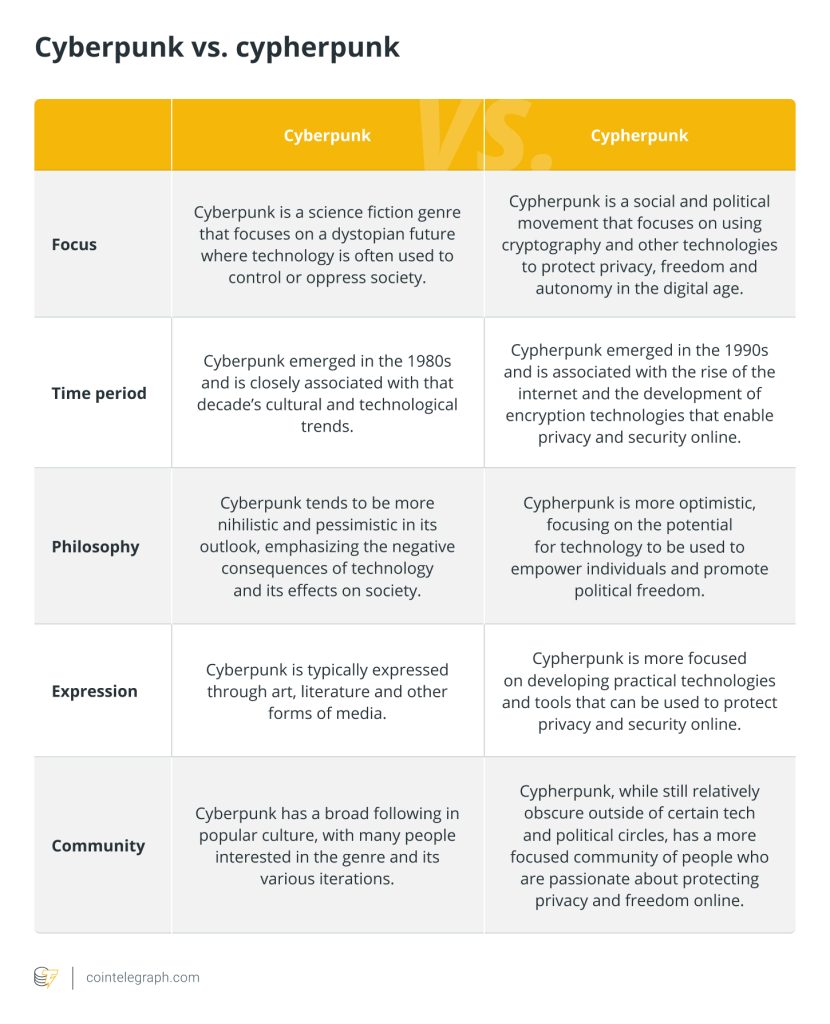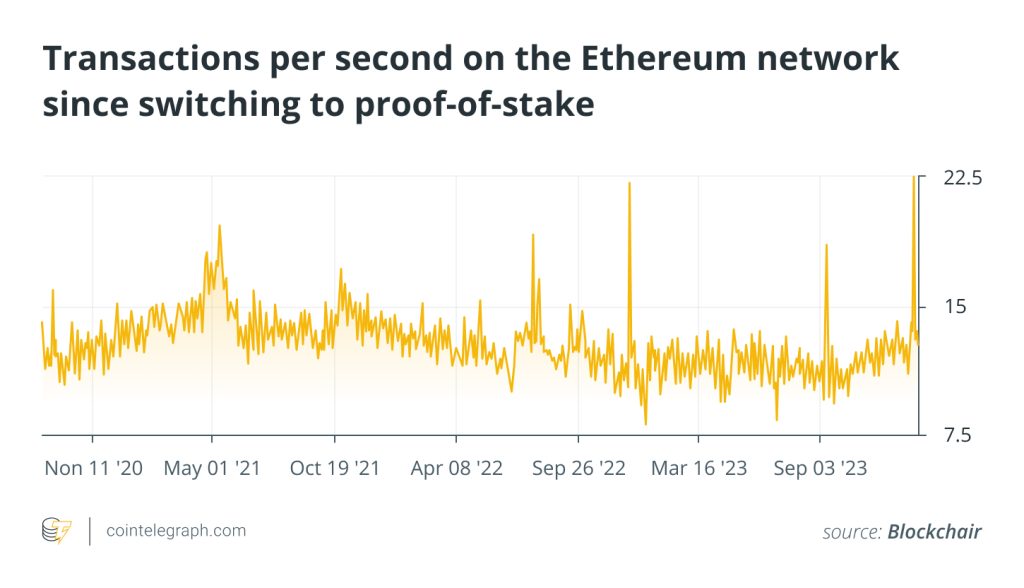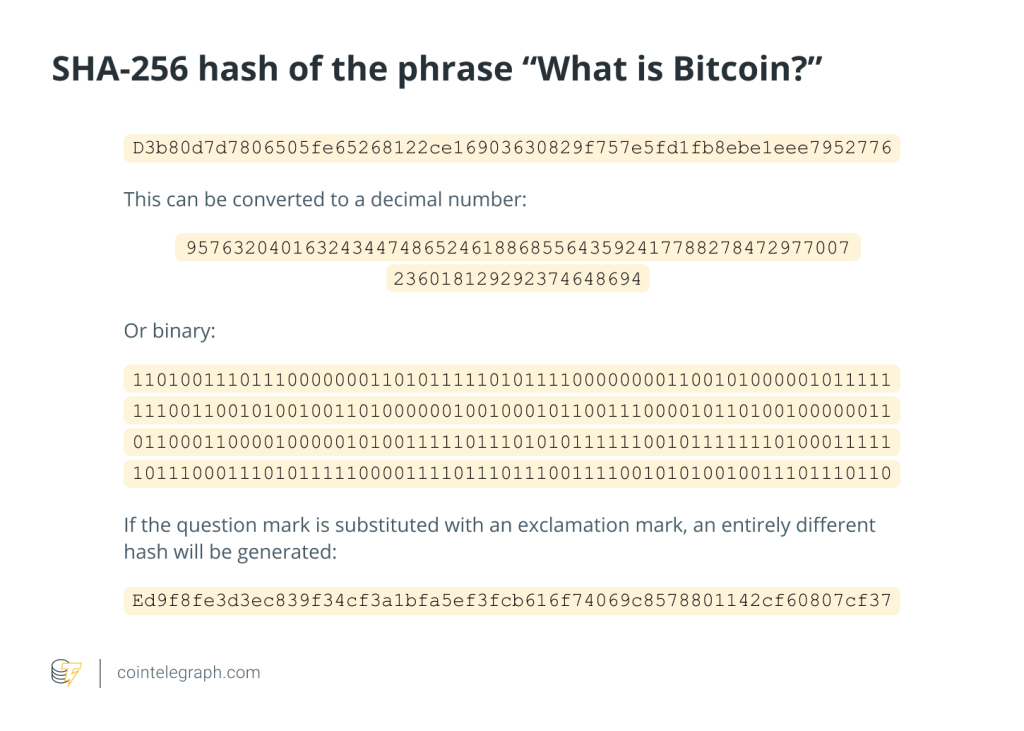What is cypherpunk?


Cypherpunk, explained
A movement known as “cypherpunk” advocates for the widespread application of robust cryptography and privacy-enhancing technology in order to safeguard people’s rights and advance a more open and decentralized society. The term “cypherpunk” is a combination of “cypher,” meaning code or encryption, and “punk,” which refers to the subculture of anti-establishment and do-it-yourself ethos.
In the 1980s and 1990s, in reaction to worries about governmental snooping, censorship and limitations on free speech, the cypherpunk movement was born. Cypherpunks contend that preserving one’s sense of independence and political freedom requires the capacity for secret, anonymous communication. To prevent online conversations and activities from being intercepted and spied on, they advocate the use of encryption methods, such as public-key cryptography and virtual private networks, or VPNs.
The cypherpunk movement has had a significant impact on the development of the internet and the technologies that underpin it, including blockchain and cryptocurrencies. As well as developing privacy-focused projects, such as the Electronic Frontier Foundation, the Tor Project and the Pretty Good Privacy (PGP) encryption software, many cypherpunks were also heavily active in the development of these projects.
Who are cypherpunks?
Cypherpunks are a wide group of people who value privacy, individual freedom and cryptography. They have backgrounds in activism, politics, law, computer science and other fields. Some well-known figures associated with the cypherpunk movement include:
- Timothy C. May: May was a computer scientist from the United States who helped launch the Cypherpunks mailing list in 1992. May was a fervent supporter of using cryptography to safeguard freedom and privacy.
- Julian Assange: Assange is an Australian journalist and activist who helped start WikiLeaks, a website that disseminates stolen information from corporations and governments. Assange is a contentious individual who has engaged in a great deal of legal conflict and political controversy.
- Phil Zimmermann: He is an American software engineer who developed the well-known email encryption programme PGP. Due to PGP’s robust encryption, Zimmermann was under investigation by the U.S. government for allegedly breaking arms export rules.
- Computer engineer Wei Dai, a Chinese-American, is credited with developing the idea of “cryptocurrency” in 1998. Dai put out the notion of employing encryption to build a decentralized digital currency that would be independent of a centralized authority.
- Nick Szabo: Nick Szabo is a computer scientist from the U.S. who is credited with developing digital currency and smart contracts. Szabo is the inventor of Bit Gold, a forerunner of Bitcoin (BTC), and is a prolific writer on the subject of how law and encryption interact.
These individuals, along with many others, have helped shape the cypherpunk movement and have contributed to the development of technologies that prioritize individual privacy and autonomy.
Is cyberpunk the same as cypherpunk?
No, cyberpunk and cypherpunk are not the same thing. While the terms “cyber” and “cypher” are similar, they refer to different things. “Cyber” typically refers to technology or computer networks, while “cypher” refers to code or encryption.
Cyberpunk is a science fiction genre that first appeared in the 1980s, is defined by a dystopian future in which cutting-edge technology is frequently employed for evil ends, and where society is ruled by ruthless corporations or governments. Cyberpunk frequently depicts a gritty, urban setting where characters break the law while utilizing technology to hack into computer systems or improve their physical capabilities.
In contrast, the 1990s saw the emergence of the cypherpunk movement, a political and social movement centered on the use of cryptography and other technology to safeguard personal freedom and privacy. Cypherpunks hold that maintaining one’s individual autonomy and political freedom requires the capacity to communicate and conduct business online without being subject to governmental or corporate surveillance.
While some of the dismal future views prevalent in cyberpunk are shared by cypherpunk, the movement is more concerned with harnessing technology to foster an open and decentralized society than it is with portraying a grim future.

Is Satoshi Nakamoto a cypherpunk?
Satoshi Nakamoto is often considered to be a cypherpunk or at least someone who is closely aligned with the cypherpunk movement due to the design and implementation of the cryptocurrency Bitcoin.
The exact identity of Satoshi Nakamoto is still unknown, but in 2008, a white paper describing the idea of a decentralized, digital currency called Bitcoin used the name as a pseudonym. The paper was published to a cryptography mailing list, which contained many cypherpunks, and it was welcomed with enthusiasm by members of the community.
Many cypherpunk ideas are incorporated into the design of Bitcoin, including the use of robust cryptography to safeguard privacy and secure transactions, the capacity to conduct transactions without relying on a centralized authority, and the capacity to achieve pseudonymity and anonymity.
The development of Bitcoin has also helped the cypherpunk movement come closer to its objective of creating technologies that can offer privacy, security and autonomy in the digital era. The creation of additional cryptocurrencies and blockchain technologies, which have the potential to advance the objectives of the cypherpunk movement, have also been influenced by Satoshi Nakamoto’s work.
While the true identity of Satoshi Nakamoto remains a mystery, the work done under that pseudonym has had a significant impact on the cypherpunk movement and the development of technologies that prioritize individual privacy and autonomy.
The ethics of cypherpunk
The foundation of cypherpunk ethics is the notion that people should be in charge of their own personal data and that powerful encryption technologies are a crucial instrument for attaining that objective.
In addition, cypherpunk ethics recognize that using encryption technology can be utilized for evil intentions, such as covering up criminal conduct or supporting terrorism. As a result, there is conflict between the necessity for public safety and security and the need for individual privacy.
By putting an emphasis on responsibility, transparency and ethical use of encryption technologies, cypherpunk ethics aims to strike a balance between these conflicting concerns. They promote the creation of secure cryptography that is openly accessible and whose performance can be independently verified. They also stress the significance of responsible usage, making sure that encryption is not employed to support illegal activity or other negative deeds.
Finally, cypherpunk ethics are founded on the belief that privacy is a fundamental human right and that technology can be used to protect that right without jeopardizing security or public safety. By adhering to these ideas, cypherpunk has significantly contributed to the advancement of encryption technologies that enable people to take charge of their digital lives and preserve their privacy.
The future of cypherpunk: Trends and innovations to watch
The cypherpunk movement has been at the forefront of the development of privacy-enhancing technologies and tools for several decades. As technology continues to evolve, there are several trends and innovations to watch that will impact the future of cypherpunk.
The growing use of distributed and decentralized systems is one trend to keep an eye on. By eliminating centralized points of control and making it more challenging for governments or businesses to monitor and regulate user activities, these systems, including blockchain and decentralized messaging platforms, offer better privacy and security.
Another topic to watch is the development of quantum-resistant encryption. Although the encryption methods used today are very secure, quantum computer assaults can still exploit them. The cypherpunk community will be heavily focused on creating new encryption techniques that are immune to quantum attacks in the next few years.
Last but not least, privacy is seriously threatened by the expanding use of artificial intelligence and machine learning in data analysis and monitoring. To mitigate these risks, the cypherpunk community will need to invent new technologies, such as stronger privacy-preserving algorithms and tools for anonymous communication.






… [Trackback]
[…] Info to that Topic: x.superex.com/academys/beginner/2244/ […]
… [Trackback]
[…] Read More to that Topic: x.superex.com/academys/beginner/2244/ […]
… [Trackback]
[…] Read More here on that Topic: x.superex.com/academys/beginner/2244/ […]
… [Trackback]
[…] Read More Info here to that Topic: x.superex.com/academys/beginner/2244/ […]
… [Trackback]
[…] Read More on on that Topic: x.superex.com/academys/beginner/2244/ […]
… [Trackback]
[…] Information to that Topic: x.superex.com/academys/beginner/2244/ […]
… [Trackback]
[…] Here you will find 66947 additional Info on that Topic: x.superex.com/academys/beginner/2244/ […]
… [Trackback]
[…] Information to that Topic: x.superex.com/academys/beginner/2244/ […]
… [Trackback]
[…] Info to that Topic: x.superex.com/academys/beginner/2244/ […]
… [Trackback]
[…] Info on that Topic: x.superex.com/academys/beginner/2244/ […]
… [Trackback]
[…] Info on that Topic: x.superex.com/academys/beginner/2244/ […]
… [Trackback]
[…] Read More to that Topic: x.superex.com/academys/beginner/2244/ […]
… [Trackback]
[…] There you will find 81362 more Info on that Topic: x.superex.com/academys/beginner/2244/ […]
… [Trackback]
[…] Find More Info here to that Topic: x.superex.com/academys/beginner/2244/ […]
… [Trackback]
[…] Read More Info here to that Topic: x.superex.com/academys/beginner/2244/ […]
… [Trackback]
[…] Info on that Topic: x.superex.com/academys/beginner/2244/ […]
… [Trackback]
[…] Find More on to that Topic: x.superex.com/academys/beginner/2244/ […]
… [Trackback]
[…] Read More Info here on that Topic: x.superex.com/academys/beginner/2244/ […]
… [Trackback]
[…] Info to that Topic: x.superex.com/academys/beginner/2244/ […]
… [Trackback]
[…] Read More on to that Topic: x.superex.com/academys/beginner/2244/ […]
… [Trackback]
[…] There you can find 14310 additional Information to that Topic: x.superex.com/academys/beginner/2244/ […]
… [Trackback]
[…] Find More on that Topic: x.superex.com/academys/beginner/2244/ […]
… [Trackback]
[…] Read More here to that Topic: x.superex.com/academys/beginner/2244/ […]
… [Trackback]
[…] Info to that Topic: x.superex.com/academys/beginner/2244/ […]
… [Trackback]
[…] Find More here to that Topic: x.superex.com/academys/beginner/2244/ […]
… [Trackback]
[…] Find More Info here on that Topic: x.superex.com/academys/beginner/2244/ […]